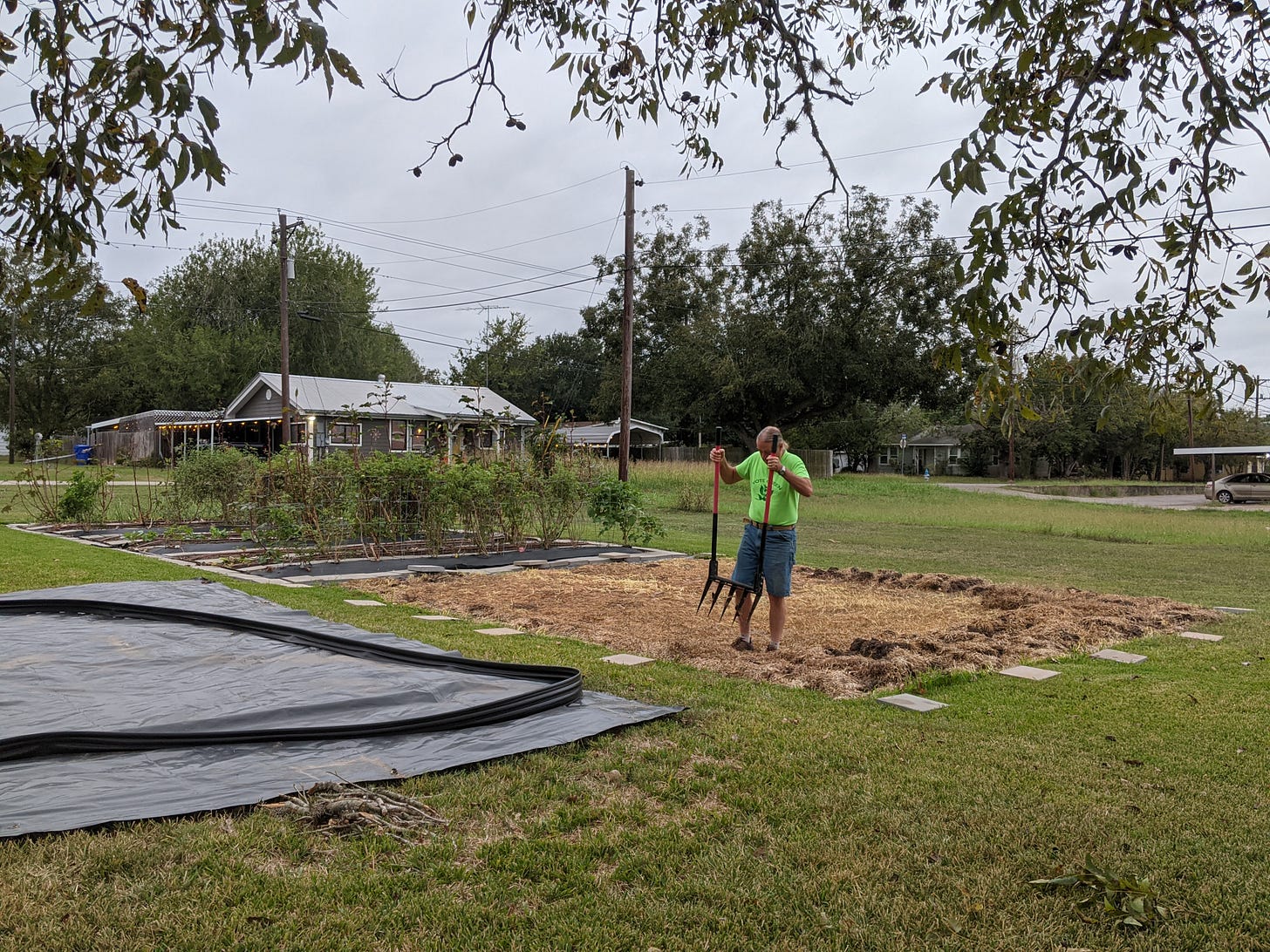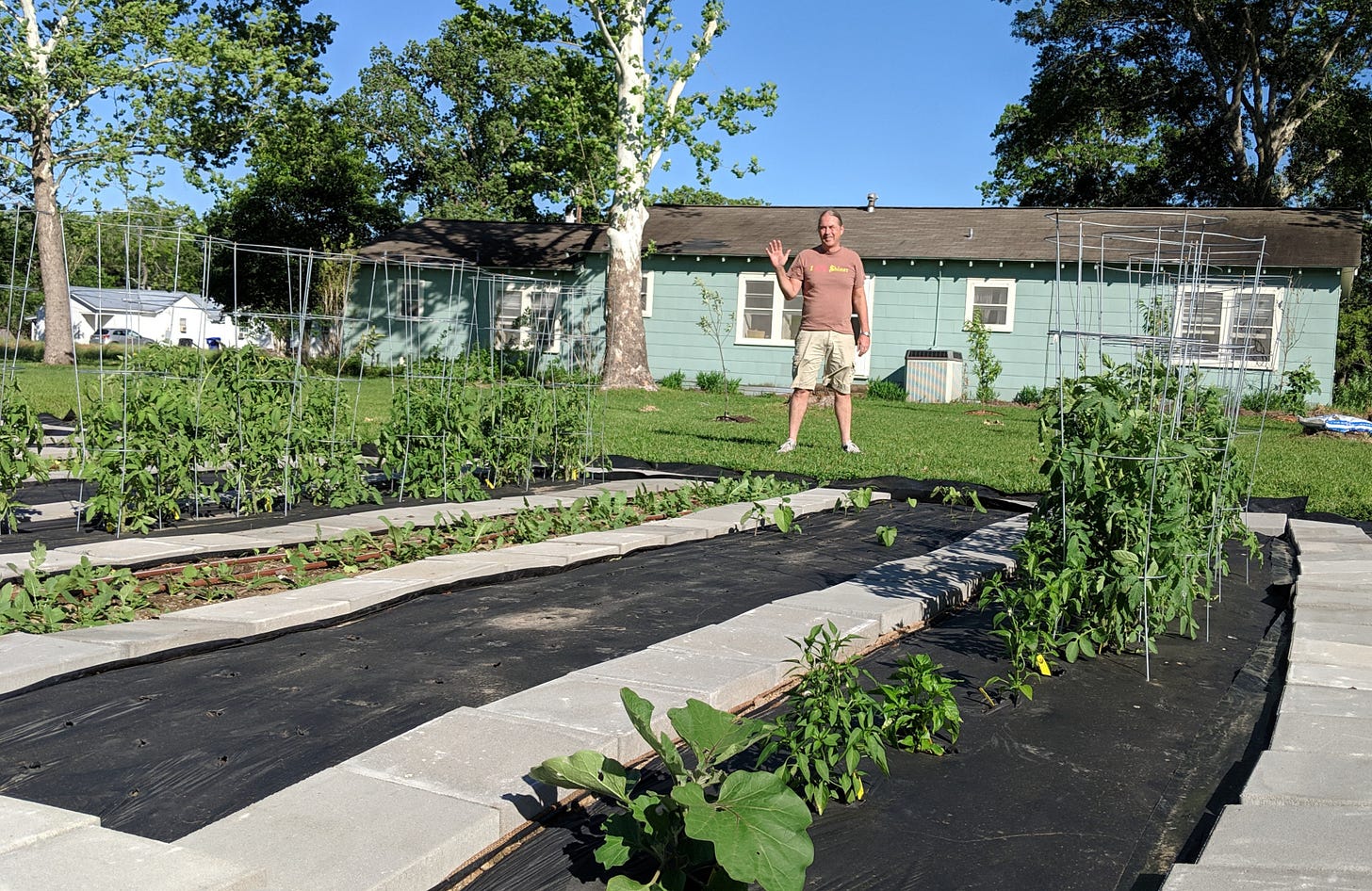Part 2: Preparing Your Kitchen Garden
After you have located a garden area that will have adequate light, a good southern exposure to the sun, dig all the way around the perimeter with a sharp shovel, to determine if there are tree roots entering your garden patch. If there are and you cut through them with the shovel, they will grow back next year. If there are large enough roots that you cannot cut them with your shovel, then a tree is already drawing a lot of water from that area. You may use a pick-axe to cut through them, but they will also re-establish, and will out-compete annual vegetables for water.
If there are a lot of rocks in the soil, they will be a lot of work to remove. I removed about 3 truck beds of rocks from my Austin garden one at a time, which took so many hours and a lot of work with a broadfork, and on hands and knees digging rocks from clay soil. You might not want to do that. You might have to pay somebody else a lot of money to do that. It might or might not be worth it for you.
Is the soil sandy, dense clay, loose loam, sandy loam, clay loam? Does it have good "tilth", both sticking together when compressed, and breaking up easily in your hand?
Dense clay soils may benefit from working in some sand as an amendment. Sandy sols will generally benefit from working in rich compost, and will need regular watering, since they won't retain water.
It is good to send your soil off for analysis before choosing amendments.
It is also important to consider how you will get your amendments carried to your garden and how you will work them in. a 400 square foot garden will need 2-4 cubic yards of composted mulch on top of the beds, if nothing else. That is 2 to 4 loads in my 25 year old Ford Ranger, which can carry 1 to 1.5 cubic yards of compost, but only half a cubic yard of heavy sand. I need to have a tarp over the bed, well tied down, to prevent compost blowing away on the road.
When the compost or other amendment gets to the garden site, I need to shovel it out of the truck, into a wheelbarrow, and spread it onto the garden with a shovel. Some suppliers of soil amendments will carry them to your driveway and dump them for a fee, but you will still need to shovel them into the wheelbarrow, carry it to the garden, and spread the amendments on the surface with your shovel. The flexor tendons of my left wrist are still a bit sore from doing that with just one cubic yard of compost a few days ago. You might need to hire some help, and you would want help that is familiar with vegetable gardening, not just ornamental gardens.
There are a lot of weed seeds in any soil. Covering the bed with a sheet of black plastic, held down with ground staples around the edges, for 4-6 months of sun, may help dormant seeds sprout, and then die, and partly sterilize the soil. Something like this is what you seek. https://thetarpswholesaler.com/10-ft-x-100-ft-black-4.5-mil-plastic-poly-sheeting-mp-1150
You might save the used black plastic and cut it into border to go around your beds, to help reduce grass and weed invasion. I staple it down and put walkway pavers over it, myself, but most people don't. However, most people roto-till every spring, and I don't.
After "sterilizing" the bed for 4-6 sunny months, and spreading amendments evenly on the surface, breaking up the soil deeply with a broadfork will help get the amendments to drop down deep into it. This is fairly heavy work, more with clay soil, sometimes impossible with rocks. Not everybody does this, but it opens the soil up to about 10 inches. Doing this before using a heavy roto-tiller helps the roto-tiller work better also, getting a more even mix of soil and amendments.
Light surface-tilling for weeds, as some people do annually, is not enough to work amendments into the soil. You might not need amendments. Some soil is wonderful. Superficial tilling for weeds will be adequate, but you will still want a layer of composted mulch on top to deter weeds, retain moisture, and leech nutrients into your soil.
I like to be in my gardens, and I like room to walk between rows, and steady, dry footing, so I use 12" to 14" concrete pavers to make walkways between rows and around the perimeter of each garden. This is very nice and inviting year-round. It is an investment in your own gardening future, assuring that your garden will always welcome you. It is also a lot of work and expense, though these pavers are not individually expensive at hardware stores. They will probably deliver them for you, but somebody with a good back needs to lay them out.
The 20 foot wide black plastic sheet leads to rows that are about 20 feet long, which is a convenient length. I like the beds to be about 30" to 36" wide between the pavers, so I can step over a bed, or straddle a bed to plant and pull weeds, with my feet on pavers. The bed width should fit what is comfortable for your body. It is your garden.
This means that each row and paved-walkway is about 4 ft total width. If you want 6 rows, that is 24 ft total width. It is good to add another foot for the perimeter pavers.
Some areas have mild summers with frequent and reliable rains. Central Texas does not. I need a timed drip watering system, watering daily, to keep a garden alive through Texas summer. The brown drip hose with close (6 inch) dripper spacing is pretty good, and a double loop for each row will be needed.
https://www.homedepot.com/p/DIG-0-50-in-x-100-ft-Earthline-Brown-PC-1-GPH-Pressure-Compensating-Drip-or-Emitter-Line-Tubing-with-12-in-Spacing-700-B12100/308160232
This can be bought in bulk, and other hose, fittings and pressure regulator will be needed. A battery operated timer on a city-water faucet is a necessity for me in central Texas.
Winter work includes mulching, weeding, top-dressing the beds with compost. I top dress with nutrient rich organic compost in a no-till arrangement, after the initial bed preparation. The beds gradually absorb a lot of the nutrients. The soil is not compacted, because of the pavers, and not walking in the beds. The roots are left in the soil, keeping it opened, and putting organic matter into it. I cut the plants off above the soil and compost them, locally in Yoakum, but the city composts in Austin, and makes a product , "Dillo-Dirt" for sale.







One thing we all tend to not look at, how the black plastic is...well, plastic. Endocrine disruptors, gradually adding up from plastic nipple baby bottle to the plastic pots many plant tomatoes in. Many folks use brown corrigated cardboard instead to cover earth, (no printing or tape). Nothing is perfect, but really, this outrage at the 'feminization' of men and boys might just have a tiny bit to do with how we have all been affected by endocrine disruptors in plastics. Call me Eeyore, I am used to it. Best
All styles of gardens not using chemicals are better than what's out there now.